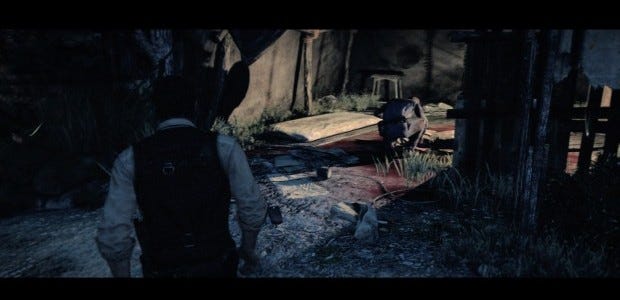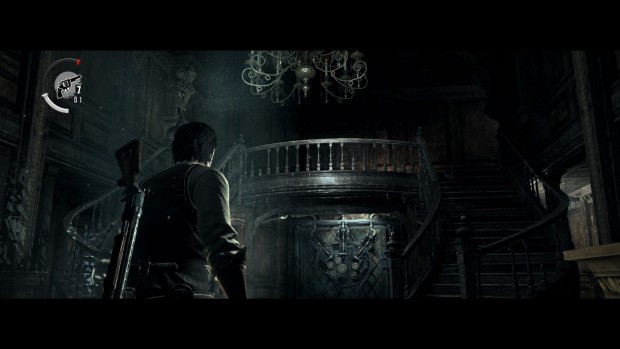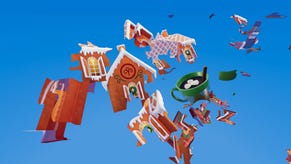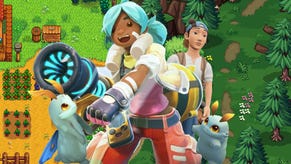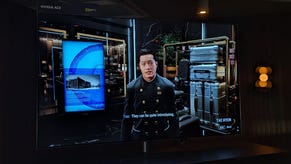The Resident Evil Within
Shinji Mikami's requiem for a nightmare
Shinji Mikami, the director of The Evil Within (TEW), directed both Resident Evil and Resident Evil 4 when at Capcom. It was always clear from TEW's title that this in some way marked a return to those roots, but about halfway through I started thinking that someone at Capcom had really pissed Mikami off. This is not just a loose reinvention and homage to Resident Evil, but one that absolutely goes for the throat in the latter stages, offering up parallels so stark the comparison is direct rather than implied. So what's Shinji saying?
Click to once again enter the world of survival horror.
There will be spoilers ahead for certain TEW locations and characters. But with that said there's one very important point about the story: this isn't really about Sebastian Castellanos as much as it is Shinji Mikami. TEW is a determined and sometimes grim-faced trawl over the moments and games that made this man's career, ranging from frame-by-frame remakes of moments like Resident Evil's first zombie head-turning to chapters that resurrect unreleased games (Chapter 9, more on which later).
And in this TEW is also the story of a genre. Resident Evil wasn't the first survival horror game, with titles like Alone in the Dark and System Shock pre-dating it, but it is the one that popularised the term and was successful enough to inspire other developers to follow in its wake (Silent Hill, another influence on TEW, is just one of them). Years later when Resident Evil badly needed a new start Capcom once again called in Mikami, and with Resident Evil 4 he moved the emphasis firmly away from horror to survival, popularising the over-the-shoulder perspective that still dominates third-person games to this day and crafting one of the best pure action games ever made.
Along the way Mikami has directed other absolute gems, prime among them God Hand (for my money the best third-person fighting game ever) and Vanquish (the best third-person shooter ever). Yet he has gone on the record as saying that TEW will be his last game as director and, if we take that at face value, has chosen to once again enter the world of survival horror. The obvious questions being why and, in the light of the somewhat divided critical reception, was it too late?
As should be clear from the above I'm something of a fan of Mikami's work, and found a lot to love in TEW. Certain criticisms are fair: the texture pop-in is noticeable, Sebastian's positioning for disarming traps and picking up items is often fiddly, and there's no denying that at certain points the camera is less than helpful. But there's also a large aspect of TEW's design that is to do with deliberate limits and has been seized upon as incompetence, in particular the black borders and the positioning of Sebastian's body on-screen.
TEW runs in a 'letterbox' format that cramps the field of view, and the camera is zoomed pretty close to Sebastian at all times. This gives you a wide horizontal perspective but the effect it creates makes you feel like you can never see quite as much as you want to, and it adds immeasurably to the sense that the walls are closing in. My absolute favourite use of this is when Sebastian opens doors and it zooms into the middle of his shoulders with almost zero peripheral vision of what's on either side, a setup that TEW constantly resists using for a cheap scare in favour of keeping you in anticipation. The vision-obscuring impact of the camera during action is also vastly overstated – you can always tell what's going on – but what bothers me about the criticism it receives is the assumption Mikami didn't realise what he was doing. If you don't like it that's fine, but this perspective is used because of its implications for the player's experience rather than being an unfortunate design flaw.
So we return to that question of why Mikami made another survival horror game. The camera is part of a larger theme in TEW, the overall effect it creates being more about tension than outright horror. Don't get me wrong, it's jam-packed full of nasties, but the game is most memorable when you're creeping along through a deserted building, twisting that camera to peer into every corner possible and listening to distant moans and thumps in the walls. I crept everywhere, long after I'd stopped using stealth tactics, because I was basically bricking it the whole time.
This may seem like splitting hairs, but TEW feels like an attempt to combine the feel of early horror games with an evolution of the more action-oriented system of Resi 4. The prime way it does this is Sebastian. In games like Resident Evil, Silent Hill and Alone in the Dark you feel constantly vulnerable, either because it's hard to kill enemies or the controls and camera angles make it hard. In Resi 4 Leon is a total badass: it's hard to feel scared by much once you've learned how to play, because he's so capable in almost any situation. Of course there's nothing wrong with that, but Sebastian is just a guy. He can't sprint for more than a few seconds before running out of breath, his punches do almost nothing to undead monsters, and when they hit him it's painful to see.
The elements of TEW's combat are similar to Resi 4, but focused changes make it an utterly different experience to play. At the most basic level Sebastian's reticule wavers a great deal more than Leon's ever did, while TEW's enemies are much more evasive and conscious of being targeted. It gives with one hand and takes with the other, so while the feedback from hitting shots in TEW is simply superb, the impact of any one shot on the Haunted is much less pronounced than it would be on Resi 4's ganados. There's nothing like hitting a sweet headshot perfectly in the centre, and simply seeing a hole in the middle of the creature's head as it continues to shamble towards you (along, of course, with a smaller hitbox to aim at). What it's done is make the gunplay more rewarding from moment-to-moment, but dialled down your character's overall effectiveness.
What it's all moving away from is the fact that Resi 4 is an action game, which leads us to perhaps the most fascinating chapter in TEW. Chapter 9 is set in what is basically a remake of the Arklay Mansion's lobby, the setting for Resident Evil. As soon as you enter and see the parallel staircases the resemblance is unmistakable. But what it chooses to do with this location is, as far as I can gather, remake an abandoned version of Resi 4.
For those of you without the time to watch, this video shows the 'hooked man' version of Resi 4 that was shown off at E3 2003 before being canned. The similarities to what happens in chapter 9 of TEW are equally unmistakable – a blue filter indicates a supernatural presence, and a seemingly-invulnerable enemy 'blinks' forwards to catch the player off-guard. But it's the setting that really makes this interesting. The 'hooked man' demo of Resi 4 suggested a much more supernatural direction for the series, and it looked pretty scary with it. Clearly Capcom decided that a more action-oriented route would suit – and so we got Resi 4 as it exists (not that I'm complaining). I can't help but see Mikami setting a version of the 'hooked man' gameplay in the Arklay Mansion as some sort of indication from the series creator that, with hindsight, he wished things had gone another way – more towards supernatural and psychological horror than balls-to-the-wall action. A belated proof-of-concept, if you will, for a dream that died.
This is not the only look-back, by a long shot. Another detail that suggests Mikami had a high opinion of the 'hooked man' iteration of Resi 4 is that the small dolls and mannequins seen throughout that demo are a constant visual theme in TEW. The 'hooked man' demo came from an even earlier prototype called the 'fog version.' Later in TEW there's a terrifying set-piece in a mannequin warehouse, with shelves piled-high surrounding Sebastian, and the entire room flooded with gas.
Dolls, vision-obscuring gas... I'm not saying that every element in TEW can or should be identified as Mikami 'saying something' about his work on the Resident Evil series, but even the less obvious parallels do seem to accumulate. This may simply be his resurrecting good ideas that, for whatever reason, never happened – not uncommon at all among great developers. Or it may be a kind of farewell to arms, an homage both to the games that never came to pass and to the teams that gave years of their lives to them behind closed doors.
There is much, much more beneath the surface of The Evil Within. Its structure is quite brilliant, allowing for an incredible variety of locations that are also metaphors for multiple characters' state of mind. The save location, for example, is a mental hospital that degenerates throughout as Sebastian gets closer to both solving the mystery and losing his own bearings. Ruvik's neediness and motivation is hinted at in his frequent invocations of his family home. One of the few things we learn for sure about Sebastian – big spoiler! – is that the loss of his daughter made him an alcoholic: the only stealth tool in the game is throwing bottles of wine to distract enemies. Want to avoid facing a situation? Turn to the bottle. It is surely pretty funny that, in a game about everyone losing their minds, you collect brains in jars to level up.
Then there are all those echoes of Resident Evil – the enemies, the similar dialogue, the parallel cutscenes, even the hints of an umbrella logo in places – almost like this world's true creator can't quite rid himself of them. Who knows what happened between Shinji Mikami and Capcom. The man himself has said the company became more business-focused and it was harder for him to take chances. Completely unverified scuttlebutt says that he felt neither he or his team were rewarded adequately for the enormous success of Resident Evil 4. What is clear is that Mikami is appreciative of and loyal to those he works with, and ambiguous with outsiders.
What Mikami is expert at is pacing a game, and creating truly memorable encounters that play out differently every time. The Evil Within shows that these skills are as strong as ever, even in a game that arguably lacks the polish of a big-budget Capcom production. It's not that I necessarily disagree with many of the criticisms levelled at TEW, I just happen to think that regardless of them it's one of the best games I've played all year – and without doubt the most intense.
This is entirely personal bias because TEW recaptures a feeling I associate with the original Resident Evil, and had long since felt was lost to time and nostalgia, that sense of being trapped somewhere and surrounded by things with claws and teeth much bigger and scarier than you are. It has been called a greatest hits collection and, while I don't agree with the metaphor, I understand where the thought's coming from. But the fact is that the future of the survival horror genre is not in games like Resident Evil, which with every passing year feel more like products of their time. Mikami must know this better than anyone else. So The Evil Within is the kind of game only the man who invented survival horror could or would have wanted to create: a requiem not just for his babies, but for all the others who never quite made it too.
